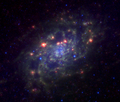NGC 2403
| Galaxy NGC 2403 |
|
|---|---|

|
|
| Image taken with a 60 cm telescope | |
| AladinLite | |
| Constellation | giraffe |
|
Position equinox : J2000.0 , epoch : J2000.0 |
|
| Right ascension | 07 h 36 m 51.4 s |
| declination | + 65 ° 36 ′ 09 ″ |
| Appearance | |
| Morphological type | SAB (s) cd HII / LINER |
| Brightness (visual) | 8.2 likes |
| Brightness (B-band) | 8.9 likes |
| Angular expansion | 23.4 ′ × 11.8 ′ |
| Position angle | 127 ° |
| Surface brightness | 14.2 mag / arcmin² |
| Physical data | |
| Affiliation | M81 group , LGG 176 |
| Redshift | (445 ± 1) · 10 −6 |
| Radial velocity | (133 ± 0) km / s |
|
Stroke distance v rad / H 0 |
(10 ± 1) x 10 6 ly (3.14 ± 0.23) Mpc |
| history | |
| discovery | Wilhelm Herschel |
| Discovery date | November 1, 1788 |
| Catalog names | |
| NGC 2403 • UGC 3918 • PGC 21396 • CGCG 310-003 • MCG + 11-10-007 • IRAS 07320 + 6543 • 2MASX J07365139 + 6536091 • GC 1541 • H V 44 • | |
NGC 2403 is a bar-spiral galaxy of the Hubble type SBc in the constellation Giraffe in the northern sky . It is around 10 million light years away from the Milky Way and has a diameter of around 70,000 light years .
It has an angular dimension of 23.4 '× 11.8' and an apparent magnitude of 8.2 mag. This galaxy, which can easily be seen in good binoculars, is one of the brightest galaxies in the northern sky that has not been included in the Messier catalog .
In the center of this galaxy are several large open star clusters with massive, very hot stars that are embedded in HII regions . From these areas we receive not only H-alpha , but also radiation in the far ultraviolet and even soft X-rays .
That means: The first of the massive stars formed here have already exploded as supernovae . Their shock waves have heated the hydrogen gas of the respective star formation region so much that it emits soft X-ray emissions. The remaining, unaffected gas is stimulated by the ultraviolet radiation of the currently existing massive stars to glow in the hydrogen lines . These also contribute to the observed distant UV radiation.
The galaxy is a member of the M81 galaxy group and is approximately 12 million light years away. In 2004, the 2004dj supernova erupted in this galaxy . As early as 2002, SN 2002kg and before that SN 1954J were observed in NGC 2403.
NGC 2403 was discovered on November 1, 1788 by the German-British astronomer Wilhelm Herschel .
Detail of the Hubble Space Telescope , illustrated
Infrared image of NGC 2403 from the Spitzer Space Telescope
Web links
- Hubble Space Telescope
- astronews.com: A supernova in NGC 2403 September 7, 2004
- Supernova SN2004dj
- M81 group at Atlas of the Universe
- NGC 2403 at SEDS
- NGC 2403 from the Subaru Telescope
- Spektrum.de: Amateur recordings: [1] [2] [3] [4]



